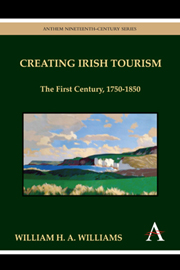Book contents
- Frontmatter
- Contents
- Preface
- Introduction
- Part I
- Part II
- Chapter 4 The Sublime and the Picturesque in the Irish Landscape
- Chapter 5 Picturesque Tourist Sites in Ireland
- Chapter 6 The Tourist Experience
- Chapter 7 Killarney—A Case Study of the Irish Tourist Experience
- Part III
- Conclusion
- Notes
- Bibliography
- Index
Chapter 6 - The Tourist Experience
from Part II
Published online by Cambridge University Press: 05 March 2012
- Frontmatter
- Contents
- Preface
- Introduction
- Part I
- Part II
- Chapter 4 The Sublime and the Picturesque in the Irish Landscape
- Chapter 5 Picturesque Tourist Sites in Ireland
- Chapter 6 The Tourist Experience
- Chapter 7 Killarney—A Case Study of the Irish Tourist Experience
- Part III
- Conclusion
- Notes
- Bibliography
- Index
Summary
The tourist experience begins and ends in the mind of the visitor, bounded by anticipation and recollection. The experience consists of those on-site activities, encounters, sights, and other sensations, along with any accumulation of souvenirs, that promise to make the tourist's visit memorable. Of course, the experiences of visitors to Ireland varied from one individual to another, depending on interests and itinerary. Many centered their primary experiences on picturesque scenery, trying perhaps to capture it in watercolors or sketches. For others the tourist experience may have included collecting information about schools, roads, ruins, farming practices or poverty. Some busied themselves investigating the conditions of the peasantry, while others were happy enough merely to be entertained by them. At the end of each day tourists made notes, finished sketches, up-dated their journals, wrote letters and planned the next day's activities.
The process by which a site becomes incorporated into tourism involves a series of steps. Although they often occur in combination with each other, initially there may be a particular sequence. For example, before a site can be toured it first must be “discovered.” This means that it is perceptually abstracted from the “ordinary” and placed in the “extraordinary” context of tourism. It becomes a sight that must be seen. Then it must be “marked”—placed on the tourist's mental as well as paper map. Although a tourist sight can be marked in many ways, naming is most important.
- Type
- Chapter
- Information
- Creating Irish TourismThe First Century, 1750–1850, pp. 107 - 128Publisher: Anthem PressPrint publication year: 2010



